Vimal Bhat
RefTok: Reference-Based Tokenization for Video Generation
Jul 03, 2025Abstract:Effectively handling temporal redundancy remains a key challenge in learning video models. Prevailing approaches often treat each set of frames independently, failing to effectively capture the temporal dependencies and redundancies inherent in videos. To address this limitation, we introduce RefTok, a novel reference-based tokenization method capable of capturing complex temporal dynamics and contextual information. Our method encodes and decodes sets of frames conditioned on an unquantized reference frame. When decoded, RefTok preserves the continuity of motion and the appearance of objects across frames. For example, RefTok retains facial details despite head motion, reconstructs text correctly, preserves small patterns, and maintains the legibility of handwriting from the context. Across 4 video datasets (K600, UCF-101, BAIR Robot Pushing, and DAVIS), RefTok significantly outperforms current state-of-the-art tokenizers (Cosmos and MAGVIT) and improves all evaluated metrics (PSNR, SSIM, LPIPS) by an average of 36.7% at the same or higher compression ratios. When a video generation model is trained using RefTok's latents on the BAIR Robot Pushing task, the generations not only outperform MAGVIT-B but the larger MAGVIT-L, which has 4x more parameters, across all generation metrics by an average of 27.9%.
CRPO: Confidence-Reward Driven Preference Optimization for Machine Translation
Jan 23, 2025



Abstract:Large language models (LLMs) have shown great potential in natural language processing tasks, but their application to machine translation (MT) remains challenging due to pretraining on English-centric data and the complexity of reinforcement learning from human feedback (RLHF). Direct Preference Optimization (DPO) has emerged as a simpler and more efficient alternative, but its performance depends heavily on the quality of preference data. To address this, we propose Confidence-Reward driven Preference Optimization (CRPO), a novel method that combines reward scores with model confidence to improve data selection for fine-tuning. CRPO selects challenging sentence pairs where the model is uncertain or underperforms, leading to more effective learning. While primarily designed for LLMs, CRPO also generalizes to encoder-decoder models like NLLB, demonstrating its versatility. Empirical results show that CRPO outperforms existing methods such as RS-DPO, RSO and MBR score in both translation accuracy and data efficiency.
Beyond Speaker Identity: Text Guided Target Speech Extraction
Jan 15, 2025Abstract:Target Speech Extraction (TSE) traditionally relies on explicit clues about the speaker's identity like enrollment audio, face images, or videos, which may not always be available. In this paper, we propose a text-guided TSE model StyleTSE that uses natural language descriptions of speaking style in addition to the audio clue to extract the desired speech from a given mixture. Our model integrates a speech separation network adapted from SepFormer with a bi-modality clue network that flexibly processes both audio and text clues. To train and evaluate our model, we introduce a new dataset TextrolMix with speech mixtures and natural language descriptions. Experimental results demonstrate that our method effectively separates speech based not only on who is speaking, but also on how they are speaking, enhancing TSE in scenarios where traditional audio clues are absent. Demos are at: https://mingyue66.github.io/TextrolMix/demo/
NowYouSee Me: Context-Aware Automatic Audio Description
Dec 13, 2024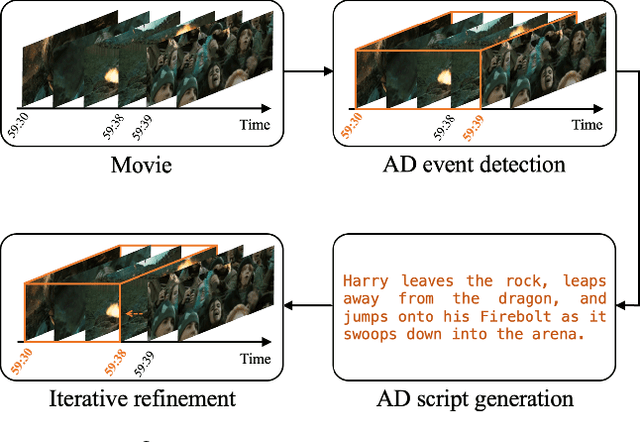
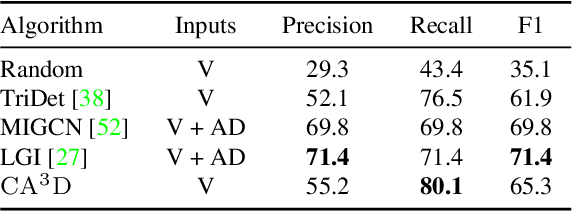
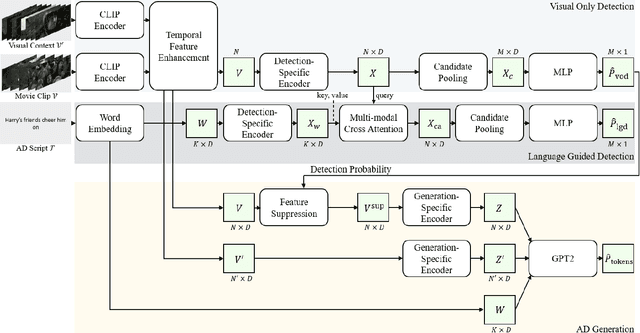
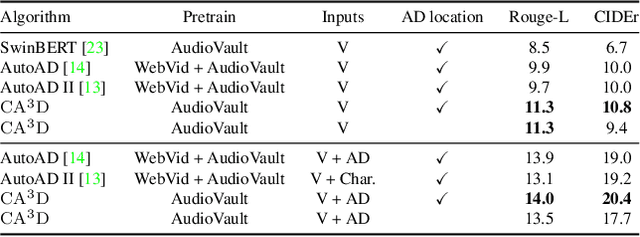
Abstract:Audio Description (AD) plays a pivotal role as an application system aimed at guaranteeing accessibility in multimedia content, which provides additional narrations at suitable intervals to describe visual elements, catering specifically to the needs of visually impaired audiences. In this paper, we introduce $\mathrm{CA^3D}$, the pioneering unified Context-Aware Automatic Audio Description system that provides AD event scripts with precise locations in the long cinematic content. Specifically, $\mathrm{CA^3D}$ system consists of: 1) a Temporal Feature Enhancement Module to efficiently capture longer term dependencies, 2) an anchor-based AD event detector with feature suppression module that localizes the AD events and extracts discriminative feature for AD generation, and 3) a self-refinement module that leverages the generated output to tweak AD event boundaries from coarse to fine. Unlike conventional methods which rely on metadata and ground truth AD timestamp for AD detection and generation tasks, the proposed $\mathrm{CA^3D}$ is the first end-to-end trainable system that only uses visual cue. Extensive experiments demonstrate that the proposed $\mathrm{CA^3D}$ improves existing architectures for both AD event detection and script generation metrics, establishing the new state-of-the-art performances in the AD automation.
* 10 pages
GEXIA: Granularity Expansion and Iterative Approximation for Scalable Multi-grained Video-language Learning
Dec 10, 2024
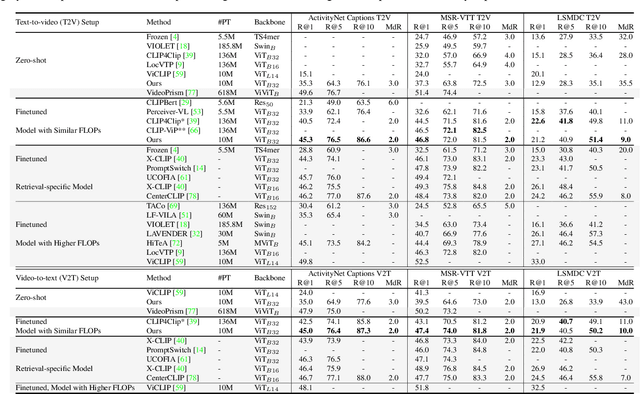

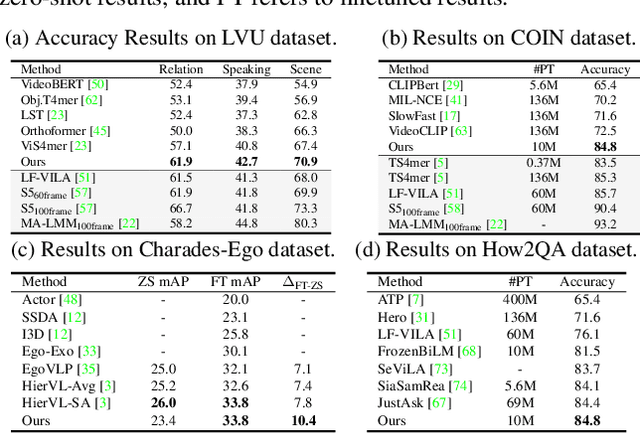
Abstract:In various video-language learning tasks, the challenge of achieving cross-modality alignment with multi-grained data persists. We propose a method to tackle this challenge from two crucial perspectives: data and modeling. Given the absence of a multi-grained video-text pretraining dataset, we introduce a Granularity EXpansion (GEX) method with Integration and Compression operations to expand the granularity of a single-grained dataset. To better model multi-grained data, we introduce an Iterative Approximation Module (IAM), which embeds multi-grained videos and texts into a unified, low-dimensional semantic space while preserving essential information for cross-modal alignment. Furthermore, GEXIA is highly scalable with no restrictions on the number of video-text granularities for alignment. We evaluate our work on three categories of video tasks across seven benchmark datasets, showcasing state-of-the-art or comparable performance. Remarkably, our model excels in tasks involving long-form video understanding, even though the pretraining dataset only contains short video clips.
DiffSign: AI-Assisted Generation of Customizable Sign Language Videos With Enhanced Realism
Dec 05, 2024



Abstract:The proliferation of several streaming services in recent years has now made it possible for a diverse audience across the world to view the same media content, such as movies or TV shows. While translation and dubbing services are being added to make content accessible to the local audience, the support for making content accessible to people with different abilities, such as the Deaf and Hard of Hearing (DHH) community, is still lagging. Our goal is to make media content more accessible to the DHH community by generating sign language videos with synthetic signers that are realistic and expressive. Using the same signer for a given media content that is viewed globally may have limited appeal. Hence, our approach combines parametric modeling and generative modeling to generate realistic-looking synthetic signers and customize their appearance based on user preferences. We first retarget human sign language poses to 3D sign language avatars by optimizing a parametric model. The high-fidelity poses from the rendered avatars are then used to condition the poses of synthetic signers generated using a diffusion-based generative model. The appearance of the synthetic signer is controlled by an image prompt supplied through a visual adapter. Our results show that the sign language videos generated using our approach have better temporal consistency and realism than signing videos generated by a diffusion model conditioned only on text prompts. We also support multimodal prompts to allow users to further customize the appearance of the signer to accommodate diversity (e.g. skin tone, gender). Our approach is also useful for signer anonymization.
Text-Guided Video Masked Autoencoder
Aug 01, 2024



Abstract:Recent video masked autoencoder (MAE) works have designed improved masking algorithms focused on saliency. These works leverage visual cues such as motion to mask the most salient regions. However, the robustness of such visual cues depends on how often input videos match underlying assumptions. On the other hand, natural language description is an information dense representation of video that implicitly captures saliency without requiring modality-specific assumptions, and has not been explored yet for video MAE. To this end, we introduce a novel text-guided masking algorithm (TGM) that masks the video regions with highest correspondence to paired captions. Without leveraging any explicit visual cues for saliency, our TGM is competitive with state-of-the-art masking algorithms such as motion-guided masking. To further benefit from the semantics of natural language for masked reconstruction, we next introduce a unified framework for joint MAE and masked video-text contrastive learning. We show that across existing masking algorithms, unifying MAE and masked video-text contrastive learning improves downstream performance compared to pure MAE on a variety of video recognition tasks, especially for linear probe. Within this unified framework, our TGM achieves the best relative performance on five action recognition and one egocentric datasets, highlighting the complementary nature of natural language for masked video modeling.
Motion-Guided Masking for Spatiotemporal Representation Learning
Aug 24, 2023Abstract:Several recent works have directly extended the image masked autoencoder (MAE) with random masking into video domain, achieving promising results. However, unlike images, both spatial and temporal information are important for video understanding. This suggests that the random masking strategy that is inherited from the image MAE is less effective for video MAE. This motivates the design of a novel masking algorithm that can more efficiently make use of video saliency. Specifically, we propose a motion-guided masking algorithm (MGM) which leverages motion vectors to guide the position of each mask over time. Crucially, these motion-based correspondences can be directly obtained from information stored in the compressed format of the video, which makes our method efficient and scalable. On two challenging large-scale video benchmarks (Kinetics-400 and Something-Something V2), we equip video MAE with our MGM and achieve up to +$1.3\%$ improvement compared to previous state-of-the-art methods. Additionally, our MGM achieves equivalent performance to previous video MAE using up to $66\%$ fewer training epochs. Lastly, we show that MGM generalizes better to downstream transfer learning and domain adaptation tasks on the UCF101, HMDB51, and Diving48 datasets, achieving up to +$4.9\%$ improvement compared to baseline methods.
MEGA: Multimodal Alignment Aggregation and Distillation For Cinematic Video Segmentation
Aug 22, 2023



Abstract:Previous research has studied the task of segmenting cinematic videos into scenes and into narrative acts. However, these studies have overlooked the essential task of multimodal alignment and fusion for effectively and efficiently processing long-form videos (>60min). In this paper, we introduce Multimodal alignmEnt aGgregation and distillAtion (MEGA) for cinematic long-video segmentation. MEGA tackles the challenge by leveraging multiple media modalities. The method coarsely aligns inputs of variable lengths and different modalities with alignment positional encoding. To maintain temporal synchronization while reducing computation, we further introduce an enhanced bottleneck fusion layer which uses temporal alignment. Additionally, MEGA employs a novel contrastive loss to synchronize and transfer labels across modalities, enabling act segmentation from labeled synopsis sentences on video shots. Our experimental results show that MEGA outperforms state-of-the-art methods on MovieNet dataset for scene segmentation (with an Average Precision improvement of +1.19%) and on TRIPOD dataset for act segmentation (with a Total Agreement improvement of +5.51%)
Nearest-Neighbor Inter-Intra Contrastive Learning from Unlabeled Videos
Mar 13, 2023Abstract:Contrastive learning has recently narrowed the gap between self-supervised and supervised methods in image and video domain. State-of-the-art video contrastive learning methods such as CVRL and $\rho$-MoCo spatiotemporally augment two clips from the same video as positives. By only sampling positive clips locally from a single video, these methods neglect other semantically related videos that can also be useful. To address this limitation, we leverage nearest-neighbor videos from the global space as additional positive pairs, thus improving positive key diversity and introducing a more relaxed notion of similarity that extends beyond video and even class boundaries. Our method, Inter-Intra Video Contrastive Learning (IIVCL), improves performance on a range of video tasks.
 Add to Chrome
Add to Chrome Add to Firefox
Add to Firefox Add to Edge
Add to Edge